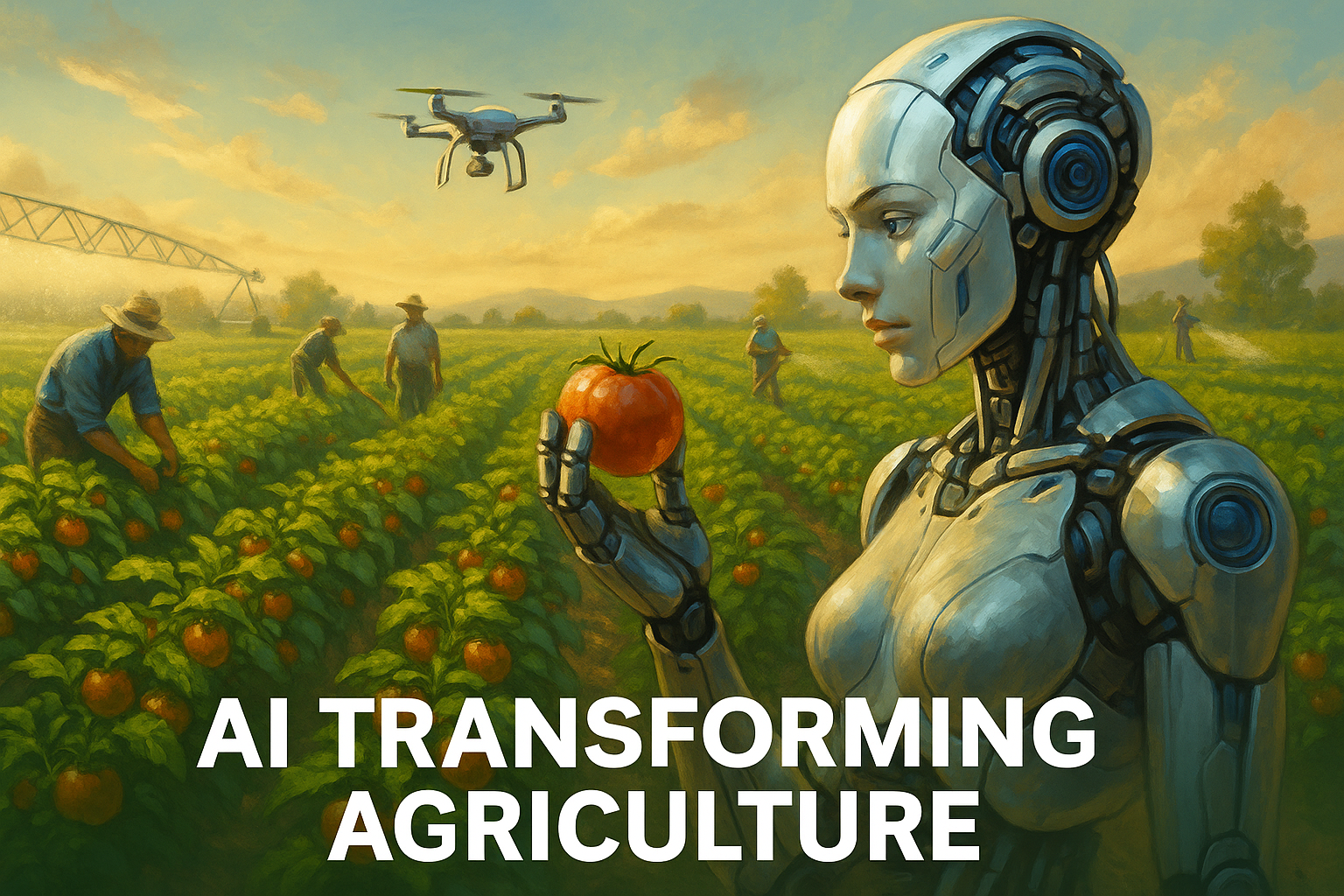From crop health scanners in Africa to robotic harvesters in Spain, AI is transforming agriculture and offering hope against global hunger and climate threats.

Report by GlobalTimesAI.com | Published August 4, 2025
Climate change, soil degradation, and population growth are placing immense pressure on global food systems. The United Nations aims to eradicate hunger by 2030, but reaching that goal demands new solutions. Today, Artificial Intelligence (AI) is stepping into the field—not as a replacement for farmers, but as a technological ally enhancing productivity, sustainability, and food security.
1. Empowering Smallholder Farmers in Sub‑Saharan Africa
In Cameroon, the startup AgrixTech, founded by Adamou Nchange Kouotou, offers an AI-powered crop advisory app. Farmers simply scan their plants using a smartphone to get instant diagnosis of disease or pest issues, with treatment suggestions based on AI analysis. This app has already benefited small-scale farmers working on degraded soils across the region, offering accessible, localized agricultural expertise
Further north in Kenya, AI tools like Virtual Agronomist and PlantVillage have helped farmers nearly triple coffee yields and accurately identify pests like fall armyworm—actions that previously relied on limited extension services. While these tools offer valuable precision, some experts caution that overuse may overshadow traditional indigenous practices The Guardian.
2. Smart Greenhouse Systems in Southern Spain
In Almería, Spain—Europe’s largest concentration of greenhouses—AI-linked IoT sensors track temperature, humidity, and soil moisture in real time. The Spanish farmer Joaquín Soriano Fernández uses these systems to manage water use and climate control, ensuring efficient irrigation while preserving scarce resources advantech.com+
These smart irrigation setups—including AI models validated against soil and weather data—can reduce water use by up to 70%, extend battery life for autonomous systems, and sustainably support yield improvements in arid regions forwardfooding.com.
3. Robotic Harvesting Helps Reduce Labor & Waste
In Madrid, engineer Roimi Fernández Saavedra is working on a two-armed harvesting robot capable of identifying ripe tomatoes and eggplants. Leveraging computer vision and robotics, this system improves harvest accuracy while reducing waste and labor dependency, especially in tight or elevated greenhouse spaces, Deutsche Welle.
4. AI Forecasting Reduces Food Waste in Germany
Food waste is a major challenge—even in developed nations. In Germany, over 11 million tons of edible food is wasted yearly in restaurants and canteens. A company canteen in Lünen now uses an AI forecasting system (powered by startups like Delicious Data) to predict meal demand and reduce overproduction—leading to significant food savings
Similarly, the ML4Mensa project at the University of Bayreuth uses machine learning to forecast daily meal demand with an accuracy of ±17 cups of coffee—demonstrating AI’s potential for operational efficiency in institutional kitchens uni-bayreuth.de.
5. Precision Agriculture: Drones, IoT & Data Analytics
Across the globe, drones, satellite imagery, and ML-based edge devices are significantly improving the monitoring of crops, soils, and pests. For example:
- An embedded AI for pest detection using low-power traps has been shown to sustain continuous monitoring in orchards without battery drain arXiv.
- In cashew plantations, AI-enabled drones using MobileNetV2 achieved up to 95% accuracy identifying diseases before visible symptoms appeared, enabling early intervention and precise pesticide use arXiv.
- African systems like NDEMRI (SMS-based advisory platform) and smartphone apps such as AgroTIC connect farmers with agronomists and buyers while leveraging machine learning for crop assessment and market access World Bank Blogs+2acadlore.com+2arXiv+2.
Impact and Barriers
According to agricultural studies, precision farming technologies (e.g., soil mapping, guided application) can increase yields by 9% to 54%, while reducing fertilizer and water usage en.wikipedia.org.
However, several challenges remain:
- High up-front costs for IoT and AI toolsets
- Connectivity and digital literacy gaps in rural areas
- Data ownership and ethics concerns, especially around use of indigenous knowledge forwardfooding.com
Final Thought: A New Chapter in Food Security
AI in agriculture is no longer a futuristic dream—it’s unlocking real-world solutions right now. From disease detection to AI-powered forecasting and precision irrigation, these tools are enhancing food security, sustainability, and farmer empowerment.
If adopted thoughtfully—with ethical data practices, inclusive training, and localized knowledge—AI could play a pivotal role in feeding the world safely and sustainably, especially in the face of climate instability and population pressures.
🔗 References:
- DW Documentary “Artificial Intelligence in Agriculture” Deutsche Welle+1emerj.com+1
- Virtual Agronomist & PlantVillage usage in Kenya The Guardian
- AgrixTech AI platform in Cameroon Deutsche Welle+2iAfrica.com+2Quartz+2
- IoT greenhouse systems in Spain’s Almería region agtechnavigator.com+1advantech.com+1
- Smart irrigation & autonomous systems research agtechnavigator.com+10agrifoodtef.eu+10uoc.edu+10
- Drone-based pest detection research arXiv+1arXiv+1
- AI demand forecasting in Germany and canteens Digital Planet+5ergo.com+5uni-bayreuth.de+5
- Precision agriculture overview studies en.wikipedia.org